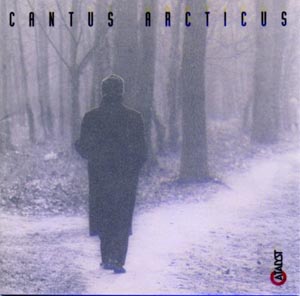 Regarded as one of Finland’s foremost contemporary composers, Einojuhani Rautavaara is a graduate of Helsinki University and the Sibelius Academy. In 1955 he was selected by Sibelius himself to receive a fellowship to study in the United States, awarded in honor of the senior composer’s 90th birthday. In America he worked with Vincent Persichetti, Roger Sessions, and Aaron Copland.
Regarded as one of Finland’s foremost contemporary composers, Einojuhani Rautavaara is a graduate of Helsinki University and the Sibelius Academy. In 1955 he was selected by Sibelius himself to receive a fellowship to study in the United States, awarded in honor of the senior composer’s 90th birthday. In America he worked with Vincent Persichetti, Roger Sessions, and Aaron Copland.
Like many contemporary European composers, Rautavaara has followed his own way in his compositions, and consequently is impossible to classify, although one can hear whispers of antecedents in many of his works.
The Cantus Arcticus of 1972 is noted, quite simply, as a “Concerto for Birds and Orchestra.” In Rautavaara’s hands, this seeming New Age moniker becomes something evocative, complex, and more than a little seductive. The first section, “The Bog,” begins sparely, a fluid solo piece for flute that progresses into a complex, but still very quiet, sometimes almost lush sequence, foreshadowing, perhaps, the bird calls to come, and serving as a reminder that the arctic is not always a frozen wasteland. “Melancholy” brings us the bird calls, again building from a spare opening to a richly textured passage that combines orchestra and birds into a seamless whole, building to an understated climax. “Swans Migrating,” the third section, begins with just that – the calls of a flock of swans, blending into an echo of the opening woodwind solo, now an ensemble piece. Listening to Cantus Arcticus, I now feel that I have a good take on what it must be like to stand in the dense boreal forest, looking out over the tundra – Rautavaara has provided a haunting picture of limitless space, limitless silence, a deep chilly peace. Lest I give the wrong impression however, while the main idea seems to be silence, it is a silence that is felt even more strongly through sound – there are passages for brass that call to mind the use Sibelius made of trumpets in his Second Symphony, but these hard, ringing peals are absorbed into the cold and the quiet, softened as though by distance. One hears the faintest whispers of Debussy, a slight tinge of Sibelius, fluent, melodious, but unremittingly individual. Yes, the bird calls are there – gulls, terns, swans — the cries of ghosts lost in fog. It is mesmerizing.
The String Quartet No. 4 (1975) is a bit more mainstream – at least, by my definition – but again, cannot quite be categorized, although there are hints of composers I’ve been listening to for nearly forty years – perhaps the more ruminative aspects of Shostakovich’s chamber works, but in a tightly conceived, three-movement format. The first movement is, in fact, fairly deceptive: it begins to sound like too many other string quartets from the late twentieth century, but the recollection never settles as one begins to notice the lyricism that quietly inserts itself into what is not quite a standard twentieth-century angst. The second and third movements take that lyrical quality farther, almost, but not quite, erasing that edge that defined the beginning. There is a great deal of subtlety in this work, played out in a tightly controlled, severely limited range that bespeaks a sensibility honed within shouting distance of the Arctic Circle.
The Symphony No. 5, from 1986, certainly fosters no ambiguity when it begins, with a reiterated chord that builds to fortissimo, shattering into dissonance until it ebbs and begins again. The first part of this symphony is big and muscular, then spirals down to a dense, intricate movement, while the occasional references to the opening keep a certain amount of dramatic tension in the mix. The ending is somehow quietly abrupt: the music tapers into a serene but somewhat mournful passage on the strings, which just – stops.
The forces arrayed – the Leipzig Radio Symphony under Max Pommer for the Cantus Arcticus and the Symphony No. 5, and the Sirius String Quartet for the String Quartet No. 4, are up to the demands of the music – Pommer had made a reputation for himself as an interpreter of contemporary music before the Leipzig Radio Symphony disbanded upon the reunification of Germany in 1991. The Sirius Quartet has worked with John Zorn, Philip Glass, John Cale and many other contemporary composers.
This is my first exposure to Rautavaara’s music, and I think he deserves more study. His work is not as overtly avant-garde as, say, Penderecki from the same period, or as overhwhelming as Arvo Pärt. There is certainly a great deal of thought behind it, and a certain kind of Romanticism, filtered through what has been going on in Eastern and Northern Europe for the last fifty years. ‘
(Catalyst/BMG Classics, 1995)
